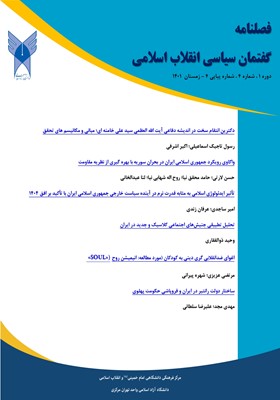تحلیل تطبیقی جنبشهای اجتماعی کلاسیک و جدید در ایران
محورهای موضوعی : فلسفه سیاسی انقلاب اسلامی
1 - پژوهشگر پسادکتری
کلید واژه: جهانی شدن, ایران, جامعه مدنی, جنبش اجتماعی, کنش جمعی,
چکیده مقاله :
رفتارهای جمعی و کنشهای اجتماعی با الهام از تحولات تاریخسازی مانند دو جنگ جهانی، ظهور جنبشهای فاشیستی- کمونیستی، اضمحلال زیستجهان استعماری و تسریع فرآیندهای جهانی شدن، در قامت جنبشهای اجتماعی ملی و فراملی رخ نمودند. متعاقب این دگردیسیهای جهانی از یک طرف، و تجربه دو انقلاب در یک قرن، جنگ هشت ساله و جهانی شدن در ایران از سوی دیگر، ماهیت جامعه معاصر تغییر یافت. به بیان دیگر، از اوایل قرن بیستم، شکاف دولت- ملت و ملت- امپریالیسم، لایههای مختلفی از جنبشهای اجتماعی به ویژه دانشجویی را بهبار آورد که درصدد تأسیس جامعه مدنی و استقرار ساختار دموکراتیک بودند. در واقع، کنشهای اجتماعی با نشستن بر کرسی رشادت و مدنیت، از سیاستزدگی و جناحگرایی حاکم بر مناسبات اجتماعی بریده و در تلاش برای رهایی از این امر سیاسی نامیمون است. طبق این فهم، پرسش اصلی نگاشته جاری این است که چگونه میتوان جنبشهای اجتماعی بهویژه دانشجویی در ایران را با الگوی تئوریک ملوچی- تورن تحلیل کرد؟ نگارنده با استخدام منطق جامعهشناسی تاریخی و روش توصیفی- تحلیلی، بر این فرضیه تأکید دارد که ماهیت، شناسهها و بسترهای متفاوت جنبشهای اجتماعی در ایران آن را در تمایز با الگوی تحلیل ملوچی- تورن قرار میدهد. یافتههای پژوهش نشان میدهد که بسترپروردگی و زمانمندی جنبشهای اجتماعی باعث میشود تا کنشهای اجتماعی در ایران لزوماً در انطباق کامل با الگوی تحلیلی ملوچی- تورن نباشند.
Collective behaviors and social actions, inspired by historical developments such as two world wars, the rise of fascist-communist movements, the collapse of the colonial ecosystem and the acceleration of globalization processes, took place in the form of national and transnational social movements. Following these global transformations on the one hand, and the experience of two revolutions in one century, the eight-year war and globalization in Iran on the other hand, the nature of contemporary society changed. In other words, since the beginning of the 20th century, the gap between the state-nation and the nation-imperialism brought different layers of social movements, especially students, who wanted to establish a civil society and establish a democratic structure. In fact, social actions, by sitting on the seat of courage and civility, are cut off from the politicization and factionalism that dominates social relations and are trying to get rid of this political issue. According to this understanding, the main question of the current writing is how to analyze social movements, especially student movements in Iran, with the Meluchi-Torn theoretical model? Employing the logic of historical sociology and the descriptive-analytical method, the author emphasizes the hypothesis that the nature, identifiers, and different contexts of social movements in Iran distinguish it from the Molochi-Torn analysis model. The findings of the research show that the background and timing of social movements make social actions in Iran not necessarily in full compliance with the analytical model of Meluchi-Torn.
_||_

